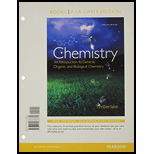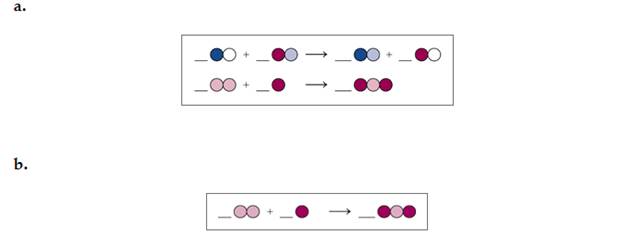
Chemistry: An Introduction to General, Organic, and Biological Chemistry, Books a la Carte Edition & Modified MasteringChemistry with Pearson eText -- ValuePack Access Card Package
1st Edition
ISBN: 9780133899573
Author: Karen C. Timberlake
Publisher: PEARSON
expand_more
expand_more
format_list_bulleted
Concept explainers
Textbook Question
Chapter 7, Problem 7.76UTC
Balance each of the following by adding coefficients, and identify the type of reaction for each: (7.4, 7.5)

Expert Solution & Answer
Trending nowThis is a popular solution!

Students have asked these similar questions
When natural light falls perpendicularly on a material A, it has a reflectivity of 0.813%. Indicate the value of the refractive index.
In piezoelectricity and piezoelectric ceramics, one of the following options is false:(A). Piezoelectricity allows an electrical signal to be transformed into a mechanical one.(B). PbZrO3 is a well-known piezoelectric ceramic.(C). Piezoelectricity and ferroelectricity in general have no relationship.(D). One of the applications of piezoelectricity is sonar.
(30 MARKS) Give the major product(s
) formed including relevant
stereochemistry or the complete
reaction conditions for the following
reactions. More than one step may be
required for each reaction arrow, in
which case the steps must be
numbered 1), 2) etc. (2 marks each
box) h)
i)
h)
OH
i)
HO
H3PO4, heat
2
Br
Chapter 7 Solutions
Chemistry: An Introduction to General, Organic, and Biological Chemistry, Books a la Carte Edition & Modified MasteringChemistry with Pearson eText -- ValuePack Access Card Package
Ch. 7.1 - What is a mole?Ch. 7.1 - What is Avogadro’s number?Ch. 7.1 - Calculate each of the following: a. number of C...Ch. 7.1 - Calculate each of the following: a. number of Li...Ch. 7.1 - Calculate each of the following quantities in 200...Ch. 7.1 - Calculate each of the following quantities in...Ch. 7.1 - Prob. 7.7QAPCh. 7.1 - Aluminum sulphate, Al2SO43 , is used in some...Ch. 7.2 - Prob. 7.9QAPCh. 7.2 - Prob. 7.10QAP
Ch. 7.2 - Prob. 7.11QAPCh. 7.2 - Prob. 7.12QAPCh. 7.2 - Prob. 7.13QAPCh. 7.2 - Prob. 7.14QAPCh. 7.2 - Prob. 7.15QAPCh. 7.2 - Prob. 7.16QAPCh. 7.2 - Prob. 7.17QAPCh. 7.2 - Prob. 7.18QAPCh. 7.2 - Prob. 7.19QAPCh. 7.2 - Prob. 7.20QAPCh. 7.2 - Prob. 7.21QAPCh. 7.2 - Prob. 7.22QAPCh. 7.2 - Prob. 7.23QAPCh. 7.2 - Prob. 7.24QAPCh. 7.2 - Prob. 7.25QAPCh. 7.2 - Prob. 7.26QAPCh. 7.3 - Determine whether each of the following chemical...Ch. 7.3 - Determine whether each of the following chemical...Ch. 7.3 - Balance each of the following chemical equations:...Ch. 7.3 - Balance each of the following chemical equations:...Ch. 7.3 - Balance each of the following chemical equations:...Ch. 7.3 - Balance each of the following chemical equations:...Ch. 7.4 - Prob. 7.33QAPCh. 7.4 - Prob. 7.34QAPCh. 7.4 - Prob. 7.35QAPCh. 7.4 - Prob. 7.36QAPCh. 7.4 - Prob. 7.37QAPCh. 7.4 - Prob. 7.38QAPCh. 7.5 - Prob. 7.39QAPCh. 7.5 - Prob. 7.40QAPCh. 7.5 - In each of the following, identify the reactant...Ch. 7.5 - In each of the following, identify the reactant...Ch. 7.5 - Prob. 7.43QAPCh. 7.5 - Prob. 7.44QAPCh. 7.5 - Prob. 7.45QAPCh. 7.5 - Prob. 7.46QAPCh. 7.6 - Write all of the mole—mole factors for each of the...Ch. 7.6 - Write all of the mole—mole factors for each of the...Ch. 7.6 - The chemical reaction of hydrogen with oxygen...Ch. 7.6 - Prob. 7.50QAPCh. 7.6 - Carbon disulfide and carbon monoxide are produced...Ch. 7.6 - Prob. 7.52QAPCh. 7.7 - Sodium reacts with oxygen to produce sodium oxide....Ch. 7.7 - Nitrogen gas reacts with hydrogen gas to produce...Ch. 7.7 - Ammonia and oxygen react to form nitrogen and...Ch. 7.7 - Iron(III) oxide reacts with carbon to give iron...Ch. 7.7 - Nitrogen dioxide and water react to produce nitric...Ch. 7.7 - Calcium cyanamide, CaCN2 , reads with water to...Ch. 7.7 - Prob. 7.59QAPCh. 7.7 - When the gases dihydrogen sulfide and oxygen...Ch. 7.8 - Prob. 7.61QAPCh. 7.8 - Prob. 7.62QAPCh. 7.8 - Classify each of the following as exothermic or...Ch. 7.8 - Classify each of the following as exothermic or...Ch. 7.8 - Classify each of the following as exothermic or...Ch. 7.8 - Classify each of the following as exothermic or...Ch. 7.8 - a. What is meant by the rate of a reaction? b. Why...Ch. 7.8 - a. How does a catalyst affect the activation...Ch. 7.8 - Prob. 7.69QAPCh. 7.8 - How would each of the following change the rate of...Ch. 7 - Prob. 7.71UTCCh. 7 - Using the models of the molecules (black = C,...Ch. 7 - A dandruff shampoo contains dipyrithione,...Ch. 7 - Ibuprofen, an anti-inflammatory drug in Advil, has...Ch. 7 - Prob. 7.75UTCCh. 7 - Balance each of the following by adding...Ch. 7 - Prob. 7.77UTCCh. 7 - Prob. 7.78UTCCh. 7 - If blue spheres represent nitrogen atoms, purple...Ch. 7 - Prob. 7.80UTCCh. 7 - Prob. 7.81UTCCh. 7 - Prob. 7.82UTCCh. 7 - Calculate the molar mass for each of the...Ch. 7 - Calculate the molar mass for each of the...Ch. 7 - How many grams are in 0.150 mole of each of the...Ch. 7 - How many grams are in 2.25 moles of each of the...Ch. 7 - How many moles are in 25.0 g of each of the...Ch. 7 - How many moles are in 4.00 g of each of the...Ch. 7 - Identify the type of reaction for each of the...Ch. 7 - Identify the type of reaction for each of the...Ch. 7 - Prob. 7.91AQAPCh. 7 - Prob. 7.92AQAPCh. 7 - Prob. 7.93AQAPCh. 7 - Prob. 7.94AQAPCh. 7 - Identify each of the following as an oxidation or...Ch. 7 - Prob. 7.96AQAPCh. 7 - When ammonia NH3 gas reacts with fluorine gas, the...Ch. 7 - When nitrogen dioxide NO2 gas from car exhaust...Ch. 7 - Pentane gas, C5H12 undergoes combustion with...Ch. 7 - Prob. 7.100AQAPCh. 7 - Prob. 7.101AQAPCh. 7 - The equation for the formation of nitrogen oxide...Ch. 7 - Prob. 7.103CQCh. 7 - Prob. 7.104CQCh. 7 - Prob. 7.105CQCh. 7 - A toothpaste contains 0.240% by mass sodium...Ch. 7 - Prob. 7.107CQCh. 7 - Prob. 7.108CQCh. 7 - Prob. 7.109CQCh. 7 - Prob. 7.110CQ
Knowledge Booster
Learn more about
Need a deep-dive on the concept behind this application? Look no further. Learn more about this topic, chemistry and related others by exploring similar questions and additional content below.Similar questions
- Nonearrow_forwardIndicate which option is false(A). Resistivity has a residual component and a thermal component.(B). In some materials resistivity increases with T and in others it decreases.(C). In insulating materials, resistivity is very low.arrow_forwardIn ceramic materials, in relation to polymorphism, the same substance crystallizes differently when external conditions vary. Is this correct?arrow_forward
- Indicate the type of bond that is considered to be a hydrogen bond.(A). Permanent dipole-dipole interaction between polar molecules.(B). Mixed ionic-covalent bond.(C). Principal interatomic bond(D). Van del Waals forces.arrow_forwardRetro aldol: NaOH H₂O H NaOH & d H₂O Harrow_forwardDraw the product of the reaction shown below. Ignore inorganic byproducts. H conc. HBr Drawing Qarrow_forward
- Calculate the atomic packing factor of diamond knowing that the number of Si atoms per cm3 is 2.66·1022 and that the atomic radii of silicon and oxygen are, respectively, 0.038 and 0.117 nm.arrow_forwardA pdf file of your hand drawn, stepwise mechanisms for the reactions. For each reaction in the assignment, you must write each mechanism three times (there are 10 reactions, so 30 mechanisms). (A) do the work on a tablet and save as a pdf., it is expected to write each mechanism out and NOT copy and paste the mechanism after writing it just once. Everything should be drawn out stepwise and every bond that is formed and broken in the process of the reaction, and is expected to see all relevant lone pair electrons and curved arrows. Aldol: NaOH HO H Δ NaOH Δarrow_forwardNonearrow_forward
- Draw structures corresponding to the following names and give IUPAC names for the following compounds: (8 Point) a) b) c) CH3 CH2CH3 CH3CHCH2CH2CH CH3 C=C H3C H H2C=C=CHCH3 d) CI e) (3E,5Z)-2,6-Dimethyl-1,3,5,7-octatetraene f) (Z)-4-bromo-3-methyl-3-penten-1-yne g) cis-1-Bromo-2-ethylcyclopentane h) (5R)-4,4,5-trichloro-3,3-dimethyldecanearrow_forwardNonearrow_forwardReview: Design a total total synthesis synthesis of the following compound using methyloxacyclopropane and any other necessary reagents.arrow_forward
arrow_back_ios
SEE MORE QUESTIONS
arrow_forward_ios
Recommended textbooks for you
 ChemistryChemistryISBN:9781305957404Author:Steven S. Zumdahl, Susan A. Zumdahl, Donald J. DeCostePublisher:Cengage Learning
ChemistryChemistryISBN:9781305957404Author:Steven S. Zumdahl, Susan A. Zumdahl, Donald J. DeCostePublisher:Cengage Learning ChemistryChemistryISBN:9781259911156Author:Raymond Chang Dr., Jason Overby ProfessorPublisher:McGraw-Hill Education
ChemistryChemistryISBN:9781259911156Author:Raymond Chang Dr., Jason Overby ProfessorPublisher:McGraw-Hill Education Principles of Instrumental AnalysisChemistryISBN:9781305577213Author:Douglas A. Skoog, F. James Holler, Stanley R. CrouchPublisher:Cengage Learning
Principles of Instrumental AnalysisChemistryISBN:9781305577213Author:Douglas A. Skoog, F. James Holler, Stanley R. CrouchPublisher:Cengage Learning Organic ChemistryChemistryISBN:9780078021558Author:Janice Gorzynski Smith Dr.Publisher:McGraw-Hill Education
Organic ChemistryChemistryISBN:9780078021558Author:Janice Gorzynski Smith Dr.Publisher:McGraw-Hill Education Chemistry: Principles and ReactionsChemistryISBN:9781305079373Author:William L. Masterton, Cecile N. HurleyPublisher:Cengage Learning
Chemistry: Principles and ReactionsChemistryISBN:9781305079373Author:William L. Masterton, Cecile N. HurleyPublisher:Cengage Learning Elementary Principles of Chemical Processes, Bind...ChemistryISBN:9781118431221Author:Richard M. Felder, Ronald W. Rousseau, Lisa G. BullardPublisher:WILEY
Elementary Principles of Chemical Processes, Bind...ChemistryISBN:9781118431221Author:Richard M. Felder, Ronald W. Rousseau, Lisa G. BullardPublisher:WILEY

Chemistry
Chemistry
ISBN:9781305957404
Author:Steven S. Zumdahl, Susan A. Zumdahl, Donald J. DeCoste
Publisher:Cengage Learning

Chemistry
Chemistry
ISBN:9781259911156
Author:Raymond Chang Dr., Jason Overby Professor
Publisher:McGraw-Hill Education

Principles of Instrumental Analysis
Chemistry
ISBN:9781305577213
Author:Douglas A. Skoog, F. James Holler, Stanley R. Crouch
Publisher:Cengage Learning

Organic Chemistry
Chemistry
ISBN:9780078021558
Author:Janice Gorzynski Smith Dr.
Publisher:McGraw-Hill Education

Chemistry: Principles and Reactions
Chemistry
ISBN:9781305079373
Author:William L. Masterton, Cecile N. Hurley
Publisher:Cengage Learning

Elementary Principles of Chemical Processes, Bind...
Chemistry
ISBN:9781118431221
Author:Richard M. Felder, Ronald W. Rousseau, Lisa G. Bullard
Publisher:WILEY
Calorimetry Concept, Examples and Thermochemistry | How to Pass Chemistry; Author: Melissa Maribel;https://www.youtube.com/watch?v=nSh29lUGj00;License: Standard YouTube License, CC-BY